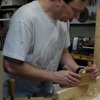LOML got me a pair of Gramercy holdfasts for Christmas. I have been looking forward to having a pair of these since I (almost) finished my bench (nearly 4.5" thick). When she wasn't looking, I took one out real quick for a test drive. Of the half dozen or so holes I tried these in (3/4 inch - drilled first with 3/4 router bit, finished last couple inches with a paddle bit), it only kinda worked in one. I whacked 'em pretty hard. Now, I know the website talks about roughening these with sandpaper, or undercutting the bottoms, but I just didn't have the time, as this was a quickly executed covert operation. Is my bench too thick? Can anyone dispel my fears, and assure me that with enough tinkering I can get these to work? Again, I've been really excited to have these.
Thanks -
Jake




 Reply With Quote
Reply With Quote







